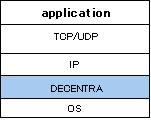DECENTRA enables wireless devices to communicate directly with each other without the need for base stations or access points. It also increases their communications coverage by making neighboring wireless devices act as data repeaters. It can be incorporated into a wide range of PCs, PDAs, and household electrical appliances that rely on wireless features. Since 2002, when the first version was released, DECENTRA has been continuously improved, finally evolving into DECENTRA Advance in 2006.

Generally, prospective customers are recommended to use DECENTRA Advance SDK to evaluate the characteristics of ad-hoc networks and develop experimental applications. Subsequently, customers usually narrow down their applications and target devices and purchase a license for this product.
DECENTRA Advance has the following features.
Hybrid route control
Skyley Networks employs a hybrid route control method that allows terminals incorporating DECENTRA to transfer data, and was one of the first vendors to put hybrid types to practical use. The hybrid type is a combination of the on-demand and table-driven types, which are being studied by MANET. The hybrid route control method offer the advantages of both types, making flexible route control easy. (US patent No. 7,092,391)
Setting parameters related to route control
Applications are allowed to change important route control parameters, such as the refresh rate, scope size, and routing table entry deletion time. So, they can flexibly handle diverse wireless networks, such as those having large numbers of mobile terminals and those having both fixed and mobile terminals evenly.
Automatic IP address forwarding allows existing TCP/IP applications to run on ad-hoc networks without modification.
The use of SDK supports access to ad-hoc network-specific features, such as routing table reference, neighboring terminal reference, flooding address, and access control.

|

